Blogs
10 Best Node.js Frameworks for App Development

Node.js has revolutionized the world of web development with its asynchronous, event-driven architecture. It has gained immense popularity for building robust and high-performing applications. To further expedite the development process and provide additional functionalities, developers have created various Node.js frameworks. In this article, we'll explore some of the best Node.js frameworks that can streamline your app development journey.
Here are the 10 Best Node.js Frameworks for App Development -
Express.js - Node.js Framework :
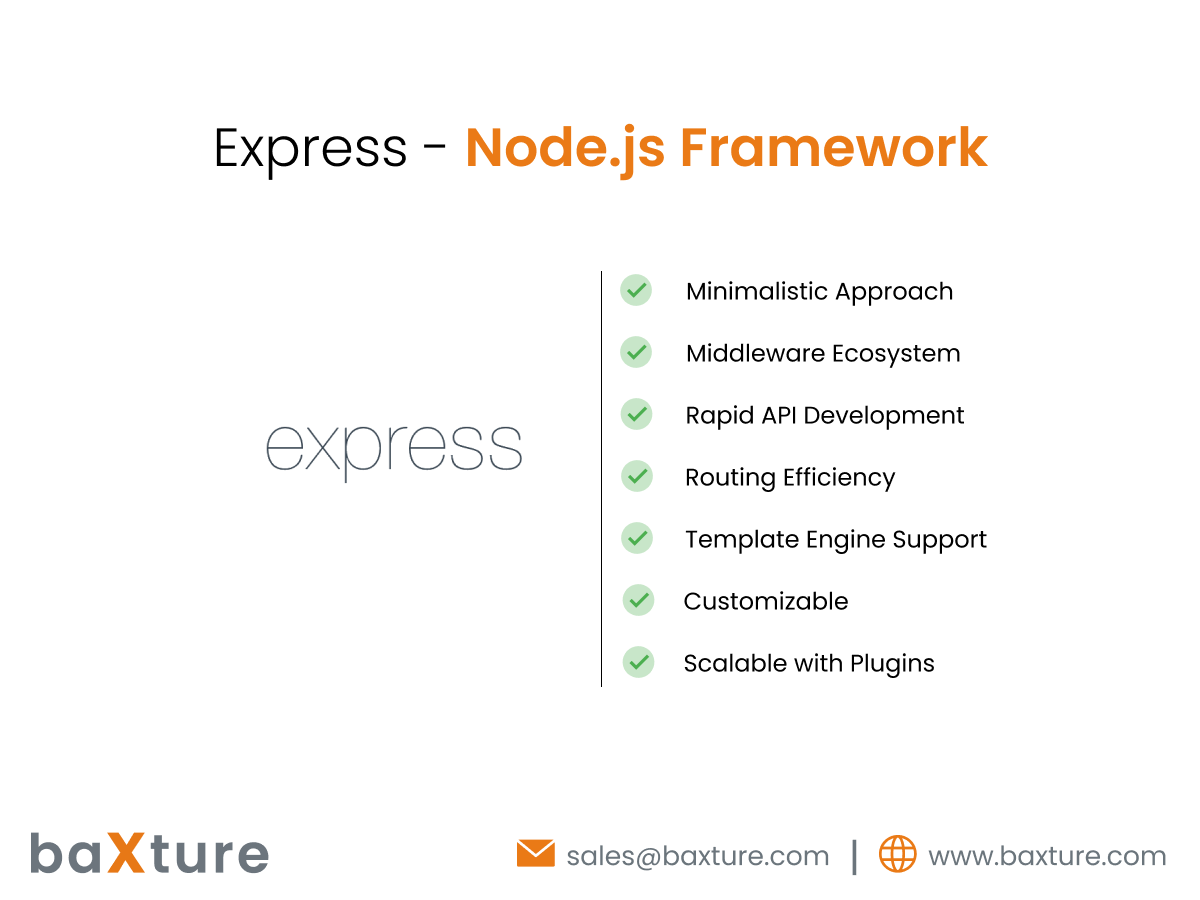
Express.js stands tall as one of the most popular and widely used Node.js frameworks. It's a minimalist framework that allows developers to build web applications and APIs with ease. Express.js is known for its simplicity and flexibility, making it an excellent choice for both beginners and experienced developers. It comes with a vast collection of middleware, which simplifies tasks like handling requests, managing cookies, and more. The large community surrounding Express.js ensures continuous support and frequent updates.
Key Features:
- Minimalistic Approach: Express.js adopts a less-is-more philosophy, enabling developers to create robust applications without unnecessary complexity.
- Middleware Ecosystem: A rich array of middleware simplifies various tasks, such as routing, authentication, and error handling.
- Rapid API Development: Express.js facilitates swift API construction, catering to the increasing demand for scalable and responsive APIs.
- Routing Efficiency: Its routing capabilities empower developers to manage endpoints and HTTP methods efficiently, enhancing application structure.
- Template Engine Support: The framework accommodates various template engines, easing the creation of dynamic views for web applications.
- Customizable: Express.js' modular structure encourages customization, enabling developers to integrate third-party libraries seamlessly.
- Scalable with Plugins: It's built to seamlessly incorporate plugins and extensions, enhancing its core functionalities based on project requirements.
When to Use:
- Prototyping: Ideal for quickly prototyping web applications, Express.js allows for rapid experimentation and concept validation.
- Microservices: Express.js' lightweight nature is suited for building microservices, where a nimble footprint is essential.
- API Development: When constructing APIs with a focus on performance and speed, Express.js excels due to its simplicity and middleware support.
- Single-Page Applications (SPAs): Express.js works well with SPAs, providing backend support for frontend-heavy applications.
- Full-Stack Applications: For comprehensive full-stack projects, Express.js can serve as the backend foundation, interacting seamlessly with frontend technologies.
- RESTful Services: Its robust routing system makes it an apt choice for creating RESTful services and APIs.
- Learning Node.js: Express.js' gentle learning curve makes it a great starting point for developers venturing into Node.js.
Express.js aligns with diverse development scenarios, ranging from prototyping to creating production-ready applications. Its flexibility, supported by an active community, guarantees ongoing assistance and enhancements for developers across the globe.
Koa.js - Node.js Framework :
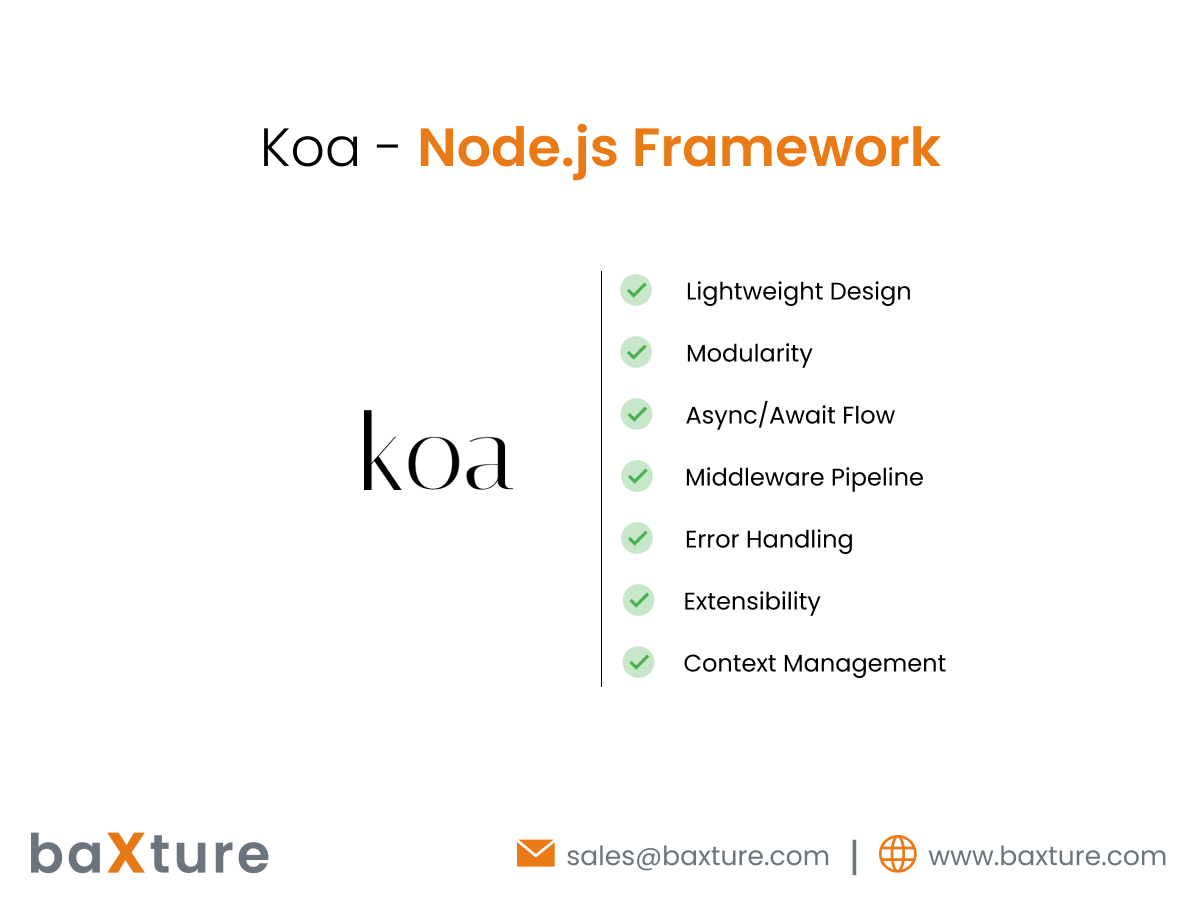
Koa.js, a brainchild of the Express.js creators, offers a distinct perspective in the realm of web frameworks. Embracing a lighter and more modular ethos, it harnesses contemporary JavaScript features to empower developers. Leveraging async/await for enhanced control flow and readability, Koa.js is particularly well-suited for intricate application architectures. Despite not reaching the same popularity as its sibling, Express.js, Koa.js is progressively gaining ground, showcasing its prowess through a combination of modern JavaScript capabilities and an uncluttered design philosophy.
Key Features:
- Lightweight Design: Koa.js prides itself on its lean structure, enabling developers to craft applications without excessive overhead.
- Modularity: Its modular approach allows developers to integrate only the components they need, promoting a clean and tailored codebase.
- Async/Await Flow: Koa.js employs async/await extensively, leading to more readable and manageable asynchronous code.
- Middleware Pipeline: The middleware system in Koa.js offers a flexible and sequential approach to handling requests and responses.
- Error Handling: With a dedicated mechanism for error handling, Koa.js simplifies the process of managing and responding to errors.
- Extensibility: Developers can create custom middleware with ease, expanding Koa.js' functionalities according to project needs.
- Context Management: Koa.js introduces a context object for each request-response cycle, easing the sharing of data between middleware.
When to Use:
- Complex Applications: Koa.js' emphasis on async/await and control flow makes it an optimal choice for constructing intricate and data-intensive applications.
- Modern JavaScript: When aiming to leverage the latest JavaScript features, Koa.js aligns well with projects that prioritize the use of contemporary coding practices.
- Microservices Architecture: Its modular nature caters to microservices, allowing developers to create specialized modules for each microservice.
- Readable Asynchronous Code: Koa.js suits developers who prioritize the readability of asynchronous code, thanks to its extensive use of async/await.
- Middleware Customization: If you require a fine-tuned middleware pipeline and custom components, Koa.js' modular structure is a beneficial fit.
- Learning Advanced Techniques: Koa.js can serve as a stepping stone for developers looking to grasp advanced asynchronous programming concepts and modern JavaScript practices.
- Uncomplicated Solutions: For projects where simplicity and streamlined design are crucial, Koa.js' lightweight and focused approach is advantageous.
Koa.js extends an invitation to developers seeking an alternative to traditional frameworks, especially those interested in harnessing the power of modern JavaScript for crafting intricate applications. Its evolving recognition within the development community is a testament to its contemporary approach and commitment to simplicity.
Nest.js - Node.js Framework :
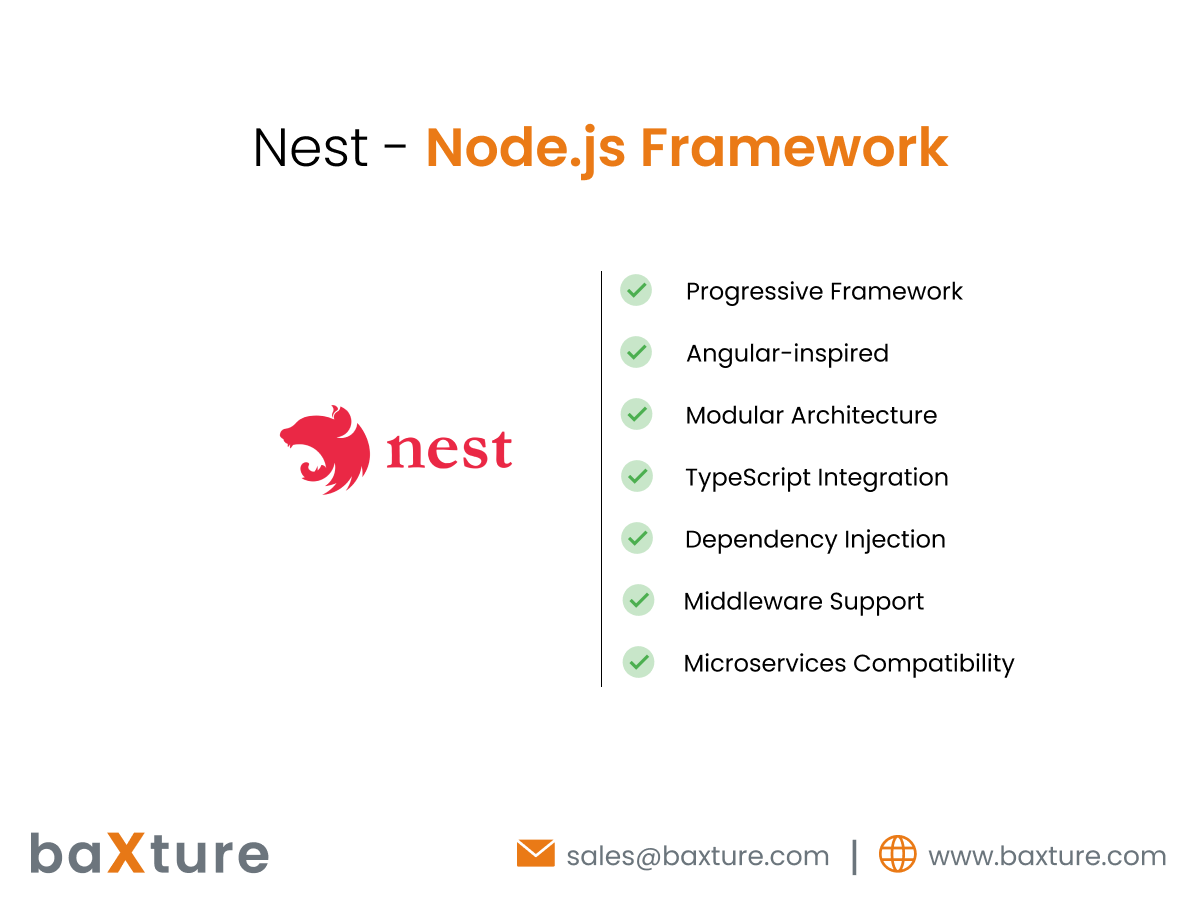
Nest.js emerges as a forward-looking Node.js framework, purpose-built for crafting server-side applications that prioritize scalability and maintainability. Marrying the user-friendliness of Angular with the robust capabilities of Express.js, Nest.js propels development to new heights. A modular architecture, fortified by TypeScript's comprehensive typing and advanced tooling, forms the backbone of Nest.js. The framework's innovative dependency injection system further refines code organization and testing procedures, cementing its position as a standout option for projects demanding a holistic and structured approach.
Key Features:
- Progressive Framework: Nest.js offers gradual adoption, allowing developers to embrace advanced features while maintaining a gentle learning curve.
- Angular-inspired: Borrowing from Angular's concepts, Nest.js simplifies development by providing familiar paradigms for those well-versed in Angular.
- Modular Architecture: Nest.js promotes modular design, enabling better code organization and encouraging the creation of reusable components.
- TypeScript Integration: With native TypeScript support, Nest.js harnesses its strong typing system for enhanced reliability and tooling.
- Dependency Injection: The framework's dependency injection system optimizes code structure, easing maintenance and testing across large-scale projects.
- Middleware Support: Similar to Express.js, Nest.js facilitates the use of middleware, streamlining tasks like authentication and error handling.
- Microservices Compatibility: Nest.js accommodates microservices architectures, offering a well-structured framework for creating and managing microservices.
When to Use:
- Scalable Applications: For projects poised for growth, Nest.js' emphasis on scalability ensures that applications can evolve without architectural roadblocks.
- TypeScript Proficiency: When a team is skilled in TypeScript, Nest.js becomes an attractive choice due to its seamless TypeScript integration.
- Complex Applications: Nest.js excels in handling intricate applications by promoting modularity and organized coding practices.
- Angular Developers: Developers familiar with Angular can transition smoothly to Nest.js, capitalizing on shared concepts and coding patterns.
- Large-scale Projects: The dependency injection system and modular architecture make Nest.js suitable for managing the complexity of expansive projects.
- Microservices Architecture: Its well-defined structure and support for microservices enable developers to create and coordinate microservices seamlessly.
- Testability and Maintainability: When testing and maintaining applications are top priorities, Nest.js' architecture and tooling provide significant advantages.
Nest.js unifies the strengths of Angular and Express.js, ushering in a framework that facilitates the creation of adaptable, robust, and maintainable server-side applications. Its alignment with modern development practices, such as TypeScript and dependency injection, signifies a commitment to delivering top-tier solutions for both present and future development challenges.
Hapi.js - Node.js Framework :
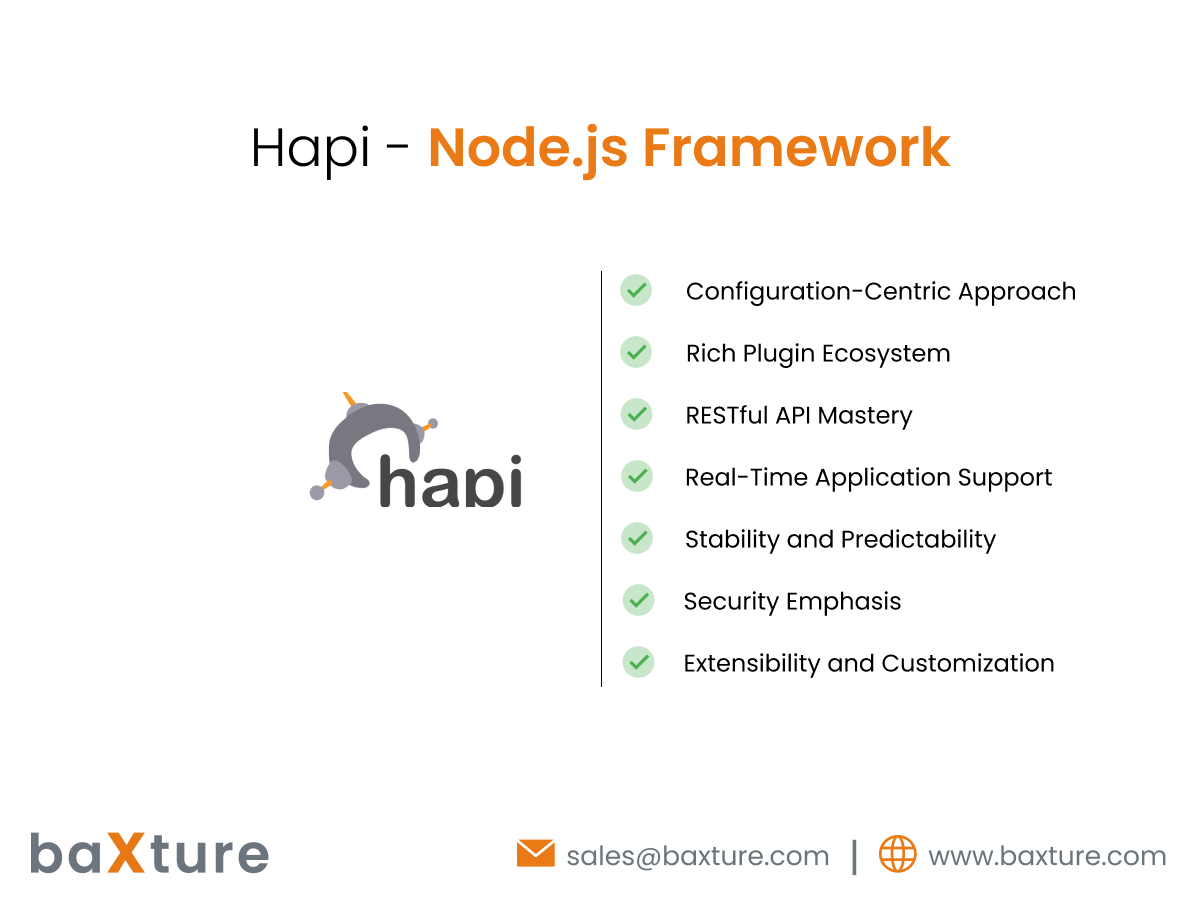
Hapi.js emerges as a robust and configuration-driven framework, placing paramount importance on stability and predictability. The framework stands out with a comprehensive suite of features and plugins, adept at addressing a wide spectrum of application requirements. Hapi.js particularly shines in the creation of RESTful APIs and real-time applications, leveraging its versatile toolset to cater to modern demands. By prioritizing configuration-centric development over excessive coding, Hapi.js empowers developers to seamlessly maintain and expand applications as they evolve. Its unwavering commitment to security and meticulous input validation further cements its appeal, especially for projects where security is a critical concern.
Key Features:
- Configuration-Centric Approach: Hapi.js emphasizes configuration, allowing developers to fine-tune application behavior without extensive code modifications.
- Rich Plugin Ecosystem: The framework's extensive array of plugins extends its capabilities, enabling developers to tailor applications to specific needs.
- RESTful API Mastery: Hapi.js excels in constructing RESTful APIs, offering tools and patterns that align with best practices for API development.
- Real-Time Application Support: With a focus on real-time interactions, Hapi.js suits applications that require efficient handling of dynamic data.
- Stability and Predictability: Hapi.js places stability at the forefront, delivering consistent behavior and reliable performance across diverse scenarios.
- Security Emphasis: The framework's built-in security measures and input validation mechanisms cater to projects demanding stringent security controls.
- Extensibility and Customization: Hapi.js' design fosters extensibility, allowing developers to build upon its foundations and create tailored solutions.
When to Use:
- Configuration-Centric Projects: For endeavors where configuration flexibility is essential to adapt to changing requirements, Hapi.js' approach is advantageous.
- Robust APIs: Hapi.js' strength in constructing well-structured, efficient APIs makes it an excellent choice for projects revolving around data exchange and connectivity.
- Real-Time Applications: When applications require real-time updates and interactions, Hapi.js' capabilities align well with dynamic data handling.
- Security-Centric Development: Hapi.js shines in security-sensitive projects, offering integrated security features and input validation for safeguarding data.
- Stability Assurance: For projects that prioritize predictable behavior and consistent performance, Hapi.js' stability-oriented approach ensures reliable outcomes.
- Plugin Extensibility: Hapi.js is ideal for applications that need to incorporate a diverse set of functionalities, thanks to its rich plugin ecosystem.
- Enterprise-Grade Applications: Its stability, security features, and configuration-driven nature make Hapi.js a valuable asset for building enterprise-level applications.
Hapi.js encompasses a comprehensive set of features and a meticulous focus on stability, appealing to developers seeking a configuration-centric approach that seamlessly harmonizes with diverse application scenarios. Its prowess in crafting RESTful APIs, real-time applications, and security-conscious projects underscores its adaptability and wide-ranging utility.
Sails.js - Node.js Framework :
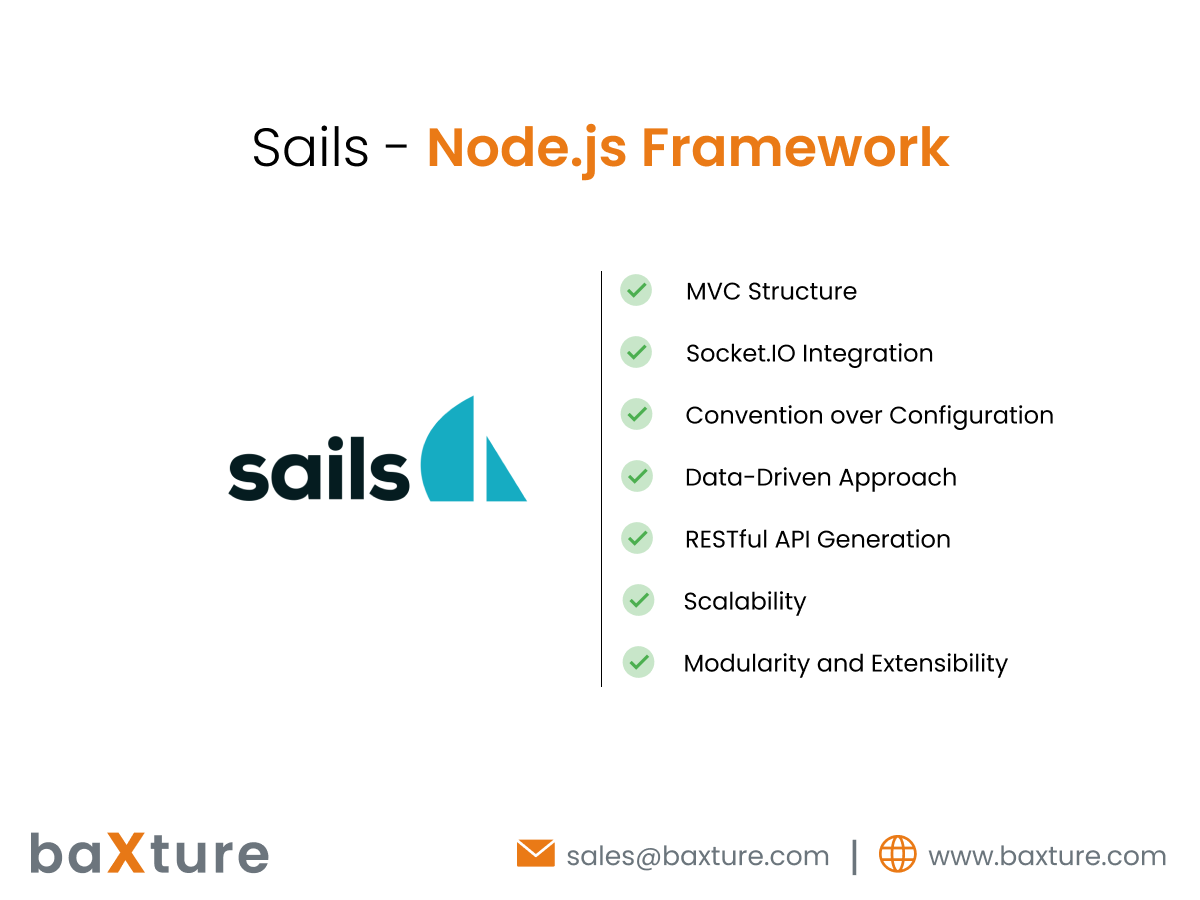
Sails.js emerges as a comprehensive MVC (Model-View-Controller) framework, elevating development through its foundation on top of Express.js. Its distinguishing feature lies in its seamless integration with Socket.IO, streamlining the creation of real-time applications. Embracing the convention over configuration philosophy, Sails.js eliminates superfluous boilerplate code, effectively expediting the development lifecycle. Underpinned by a data-centric architecture and automatic RESTful API generation, the framework shines in crafting applications characterized by dynamism and data intensity.
Key Features:
- MVC Structure: Sails.js adheres to the MVC pattern, promoting a well-organized separation of concerns in application architecture.
- Socket.IO Integration: Seamless integration with Socket.IO empowers developers to build real-time applications with ease.
- Convention over Configuration: Sails.js reduces the need for explicit configuration, allowing developers to focus on application logic rather than setup.
- Data-Driven Approach: Its data-driven architecture suits applications where efficient data management and manipulation are vital.
- RESTful API Generation: Sails.js automates the creation of RESTful APIs, simplifying the process of exposing application data over HTTP.
- Scalability: With its real-time capabilities and efficient architecture, Sails.js accommodates the growth of applications without sacrificing performance.
- Modularity and Extensibility: Sails.js encourages modular development, allowing developers to extend the framework's functionality through custom modules.
When to Use:
- Real-Time Applications: Sails.js excels in constructing real-time applications, capitalizing on its integrated Socket.IO support for seamless data synchronization.
- Data-Intensive Projects: For applications dealing with substantial data loads and requiring effective data manipulation, Sails.js' data-driven architecture is advantageous.
- Rapid Development: The convention over configuration approach, along with RESTful API generation, speeds up development cycles, making Sails.js suitable for time-sensitive projects.
- Dynamic Applications: Sails.js' inherent capabilities for real-time interactions and data management align well with projects demanding dynamic and responsive interfaces.
- API-Centric Applications: When the creation of RESTful APIs is pivotal to project goals, Sails.js' automatic API generation eases this process.
- Socket.IO Dependence: If real-time communication is a core requirement, Sails.js' integration with Socket.IO makes it an apt choice.
- Simplified Configuration: For projects seeking a streamlined setup process and reduced configuration overhead, Sails.js' convention-centric approach is beneficial.
Sails.js encapsulates the advantages of both the MVC architecture and the real-time capabilities of Socket.IO. Its commitment to minimizing configuration complexities and promoting efficient data-driven development positions it as a valuable asset for constructing applications that prioritize dynamic data handling, real-time interactions, and rapid development cycles.
Meteor.js - Node.js Framework :
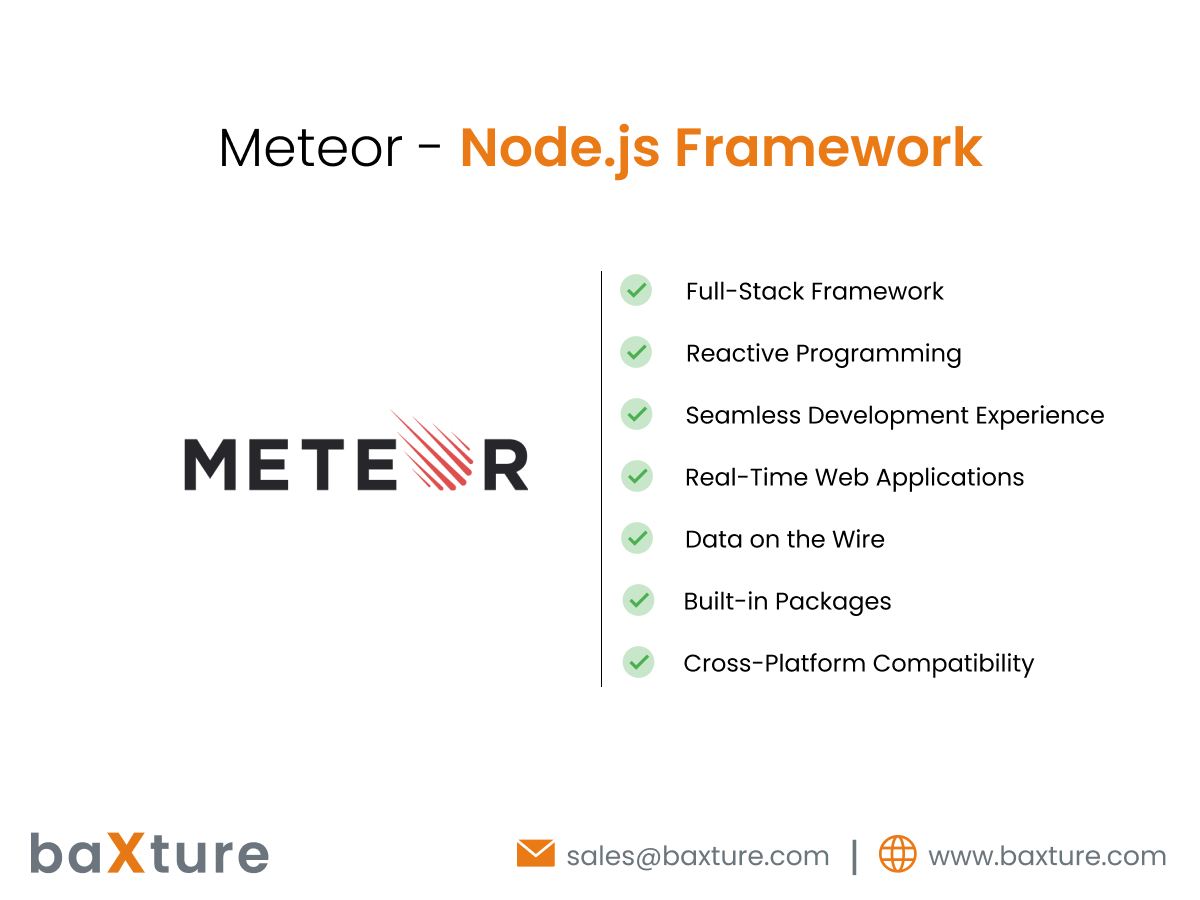
Meteor.js emerges as a comprehensive full-stack JavaScript framework, delivering a harmonious end-to-end development journey. Bridging the gap between front-end and back-end components, it empowers the creation of real-time web applications. The framework's hallmark lies in its adoption of "reactive programming," a dynamic approach that instantaneously updates the user interface in response to data changes, culminating in an immersive and interactive user experience. Bolstered by an extensive repertoire of built-in packages, Meteor.js accelerates development processes, allowing developers to swiftly prototype and craft applications with grace.
Key Features:
- Full-Stack Framework: Meteor.js covers the entire application spectrum, offering both front-end and back-end tools within a unified framework.
- Reactive Programming: The adoption of reactive programming empowers real-time updates, ensuring a dynamic and interactive user interface.
- Seamless Development Experience: Meteor.js streamlines the development process, minimizing the need for complex configurations and enabling rapid iteration.
- Real-Time Web Applications: The framework's real-time capabilities make it well-suited for building applications that thrive on instantaneous data updates and interactions.
- Data on the Wire: Meteor.js employs a "data on the wire" approach, optimizing data transfer and minimizing unnecessary data transmission.
- Built-in Packages: An extensive array of built-in packages expedites development by providing pre-made components and functionalities.
- Cross-Platform Compatibility: Meteor.js supports cross-platform development, allowing applications to be deployed across various platforms and devices.
When to Use:
- Rapid Prototyping: Meteor.js' streamlined development process and built-in packages make it an ideal choice for quickly creating prototypes and proof-of-concept applications.
- Real-Time Applications: For projects requiring real-time interactions, such as collaborative tools or chat applications, Meteor.js' reactivity is a valuable asset.
- Interactive User Interfaces: When a dynamic and interactive user experience is crucial, the framework's reactive programming ensures seamless interface updates.
- Cross-Platform Development: Meteor.js' cross-platform compatibility is advantageous when targeting multiple platforms or devices.
- Data-Intensive Applications: In projects that heavily involve data processing and manipulation, Meteor.js' "data on the wire" approach enhances efficiency.
- Single-Page Applications: Meteor.js aligns well with single-page applications (SPAs), offering a streamlined approach to creating responsive and dynamic SPAs.
- Small to Medium-Sized Projects: The framework's rapid development cycle and integrated features make it a strong contender for smaller to medium-sized projects.
Meteor.js embodies a holistic approach to development, encompassing both front-end and back-end realms. Its reactive programming philosophy and comprehensive package ecosystem underpin its suitability for real-time and interactive applications. By focusing on ease of use and providing a simplified development experience, Meteor.js empowers developers to swiftly transform ideas into functional applications.
Adonis.js - Node.js Framework :
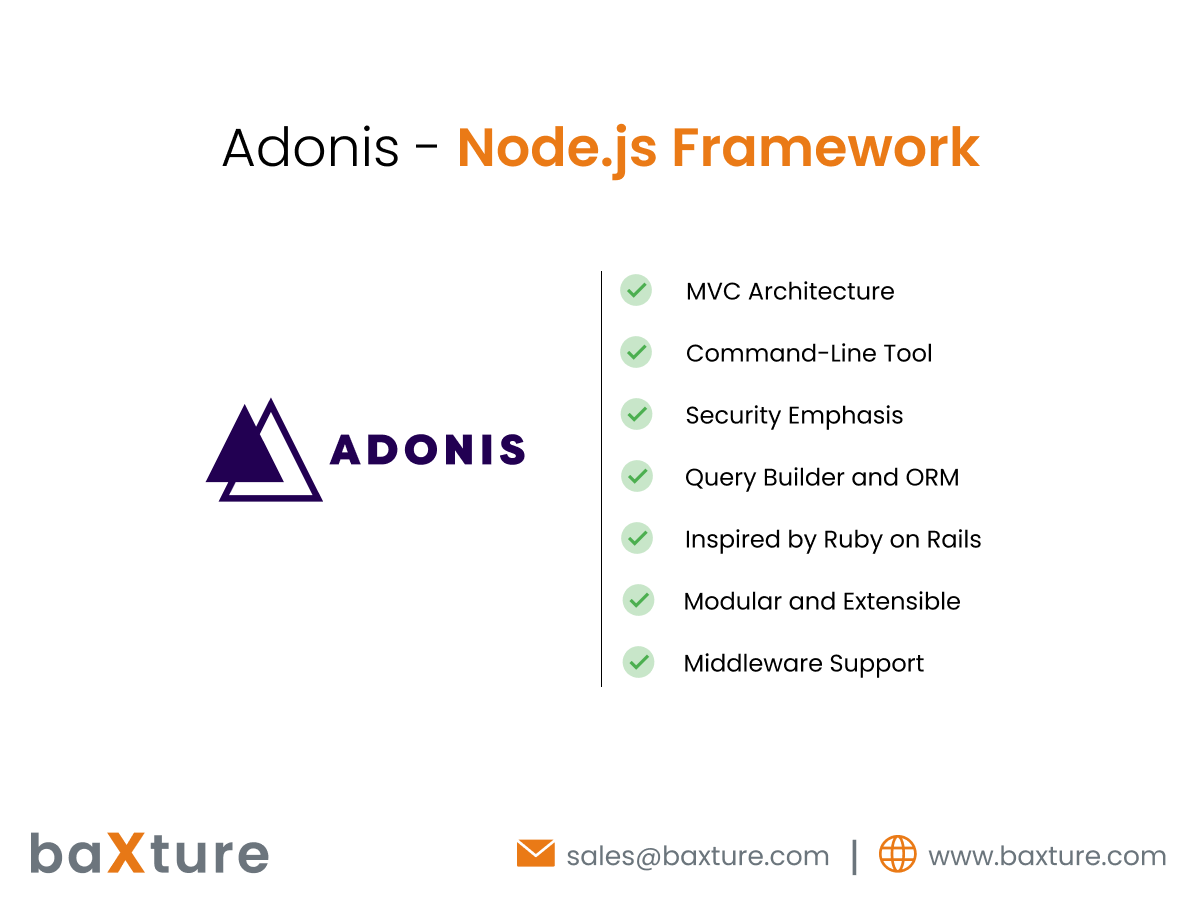
Adonis.js emerges as a comprehensive MVC framework that draws inspiration from successful counterparts like Ruby on Rails. Fueled by a feature-rich architecture, it offers developers a robust toolkit to sculpt web applications with finesse. A standout feature is its potent command-line tool, adept at scaffolding and generating application code, thus streamlining development workflows. Adonis.js garners praise for its formidable authentication and authorization mechanisms, rendering it a choice framework for constructing secure applications. Additionally, its integrated query builder and ORM expedite database interactions, further enhancing its appeal.
Key Features:
- MVC Architecture: Adonis.js adheres to the MVC pattern, promoting clear separation of concerns for more organized and maintainable code.
- Command-Line Tool: The framework boasts a potent command-line tool that simplifies various development tasks, from scaffolding to code generation.
- Security Emphasis: Adonis.js shines in the realm of security with robust authentication and authorization mechanisms, safeguarding applications against vulnerabilities.
- Query Builder and ORM: Integrated query builder and ORM enhance database interactions, making data manipulation and retrieval more streamlined.
- Inspired by Ruby on Rails: Drawing inspiration from Ruby on Rails, Adonis.js inherits productive coding patterns and principles.
- Modular and Extensible: Adonis.js' modular architecture allows developers to extend its functionality through the integration of custom modules.
- Middleware Support: Similar to other frameworks, Adonis.js facilitates the utilization of middleware for enhancing request handling and application logic.
When to Use:
- Security-Critical Applications: Adonis.js' emphasis on security makes it a go-to choice for applications where data protection and secure authentication are paramount.
- MVC Adherents: Developers accustomed to the MVC pattern and seeking to implement it in JavaScript can find familiarity and efficiency in Adonis.js.
- Efficient Database Interactions: The integrated query builder and ORM make Adonis.js a prime candidate for projects heavily reliant on database operations.
- Time-Efficient Development: When expediting development is crucial, Adonis.js' command-line tool aids in quickly scaffolding code and generating essential components.
- Web Applications: Adonis.js caters well to web application development, providing a structured foundation for constructing dynamic and feature-rich interfaces.
- Adoption of Productive Patterns: For teams accustomed to the productive practices of Ruby on Rails, Adonis.js presents a fitting counterpart in the JavaScript ecosystem.
- Authentication-Heavy Projects: Projects necessitating elaborate authentication and authorization flows can benefit from Adonis.js' robust security mechanisms.
Adonis.js combines a familiarity with the MVC paradigm, productivity-inducing features, and stringent security measures to deliver an advantageous framework for building robust web applications. Its marriage of security and developer-friendly tools makes it a valuable asset for projects seeking both resilience and efficiency in application development.
LoopBack.js - Node.js Framework :

LoopBack.js, championed by IBM, stands tall as a robust framework tailored for crafting RESTful APIs and microservices. Its prowess extends beyond mere development, as it introduces an intuitive API explorer that transforms API interaction into a seamless process. A hallmark of LoopBack.js is its versatility in handling an array of data sources—ranging from databases to REST and SOAP services—effectively unifying various data streams. Fueled by an extensible design and bolstered by community-contributed extensions, the framework's capabilities flourish further.
Key Features:
- API and Microservice Focus: LoopBack.js excels in crafting RESTful APIs and microservices, equipping developers to build efficient and scalable web solutions.
- Dynamic API Explorer: The framework introduces a user-friendly API explorer that simplifies API interaction, enhancing both development and testing phases.
- Data Source Integration: LoopBack.js supports diverse data sources, from databases to REST and SOAP services, facilitating seamless data integration.
- Extensibility: Its extensible architecture encourages developers to integrate custom modules and components, tailoring the framework to specific project requirements.
- Modular Design: LoopBack.js embraces a modular structure, fostering code organization and easing the management of complex projects.
- Community-Driven Extensions: A community of contributors augments LoopBack.js' capabilities through extensions, enriching the available tools and features.
- IBM Support: Backed by IBM, LoopBack.js benefits from substantial resources and industry backing, ensuring its continued development and reliability.
When to Use:
- API-Driven Projects: LoopBack.js' primary focus on API and microservice development makes it an apt choice for projects centered around data exchange and web services.
- Data Integration Requirements: For applications reliant on diverse data sources, LoopBack.js' support for various data types fosters seamless integration.
- Developer-Friendly Interaction: The API explorer simplifies API interaction and testing, making LoopBack.js a valuable asset in projects that require iterative development and testing.
- Modular Development: LoopBack.js' modular architecture is beneficial for projects demanding organized codebases and efficient project management.
- IBM Ecosystem Integration: Projects situated within the IBM ecosystem can leverage LoopBack.js' robust capabilities and industry support.
- Customization and Extensibility: When customization is key, LoopBack.js' extensible nature accommodates the integration of bespoke components and functionalities.
- Diverse Data Sources: For applications requiring data integration from a variety of sources, LoopBack.js' multi-source support streamlines the process.
LoopBack.js, with its API-centric focus, extensive data source support, and community-enhanced ecosystem, stands as an invaluable tool for developing robust and interconnected web applications. The framework's user-friendly features and dynamic API explorer empower developers to create efficient and responsive solutions, while its versatility in data handling adds an additional layer of value.
Total.js - Node.js Framework :
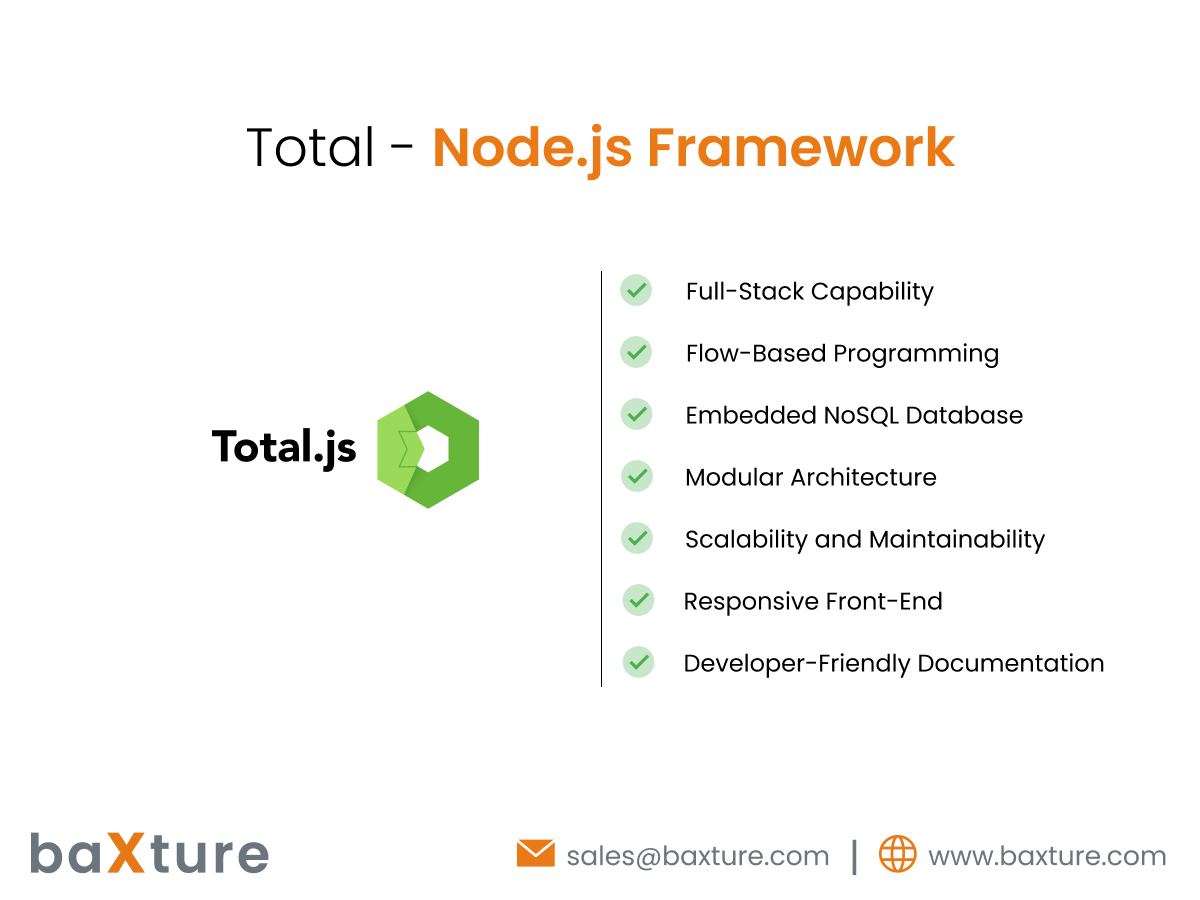
Total.js emerges as a contemporary and feature-laden Node.js framework, transcending the boundaries between front-end and back-end development. Its defining characteristic lies in its adoption of a distinctive flow-based programming paradigm, empowering developers to engineer applications that boast scalability and maintainability as their cornerstones. Beyond this, Total.js presents a NoSQL embedded database, expediting application development by bypassing the need for separate database setup. Fortified by a modular architecture and comprehensive documentation, Total.js takes its place as a framework designed with developers' ease in mind.
Key Features:
- Full-Stack Capability: Total.js spans both front-end and back-end domains, streamlining the creation of cohesive and feature-rich applications.
- Flow-Based Programming: The framework introduces a unique flow-based programming paradigm, facilitating scalable and structured code development.
- Embedded NoSQL Database: Total.js incorporates an embedded NoSQL database, accelerating application development by eliminating the need for external database setup.
- Modular Architecture: The modular design allows developers to create applications as a composition of reusable modules, enhancing maintainability and code organization.
- Scalability and Maintainability: Total.js' focus on structured programming and modular design underpins applications' scalability and ease of maintenance.
- Responsive Front-End: The framework ensures the creation of responsive front-end interfaces, aligning with modern user expectations.
- Developer-Friendly Documentation: Total.js includes extensive documentation that facilitates learning and reference, expediting the development process.
When to Use:
- Full-Stack Development: Total.js' ability to handle both front-end and back-end facets makes it an advantageous choice for projects aiming to create comprehensive applications.
- Structured Development: When seeking a structured and scalable approach to coding, Total.js' flow-based programming paradigm is conducive to maintaining clean and organized code.
- Rapid Application Development: The embedded NoSQL database speeds up application development by negating the need for external database setup, making it suitable for time-sensitive projects.
- Modular Architectures: Projects requiring modular and component-based architectures benefit from Total.js' modular design, allowing developers to create applications through reusable building blocks.
- Developer-Centric Framework: Total.js' developer-friendly documentation and modular nature make it an appealing choice for both experienced and novice developers.
- Scalable Applications: Total.js' emphasis on scalability makes it a compelling framework for applications poised for growth and increasing demand.
- Innovative Development Approach: For projects that prioritize innovative programming paradigms, Total.js' flow-based approach presents an intriguing option.
Total.js stands at the forefront of modern Node.js frameworks, embracing both front-end and back-end realms to provide a unified development experience. Its distinctive flow-based programming, embedded database, and modular design contribute to its appeal among developers seeking efficient and scalable solutions. By prioritizing structured code and maintaining a developer-friendly ecosystem, Total.js empowers developers to embark on projects with confidence and efficiency.
Feathers.js - Node.js Framework :
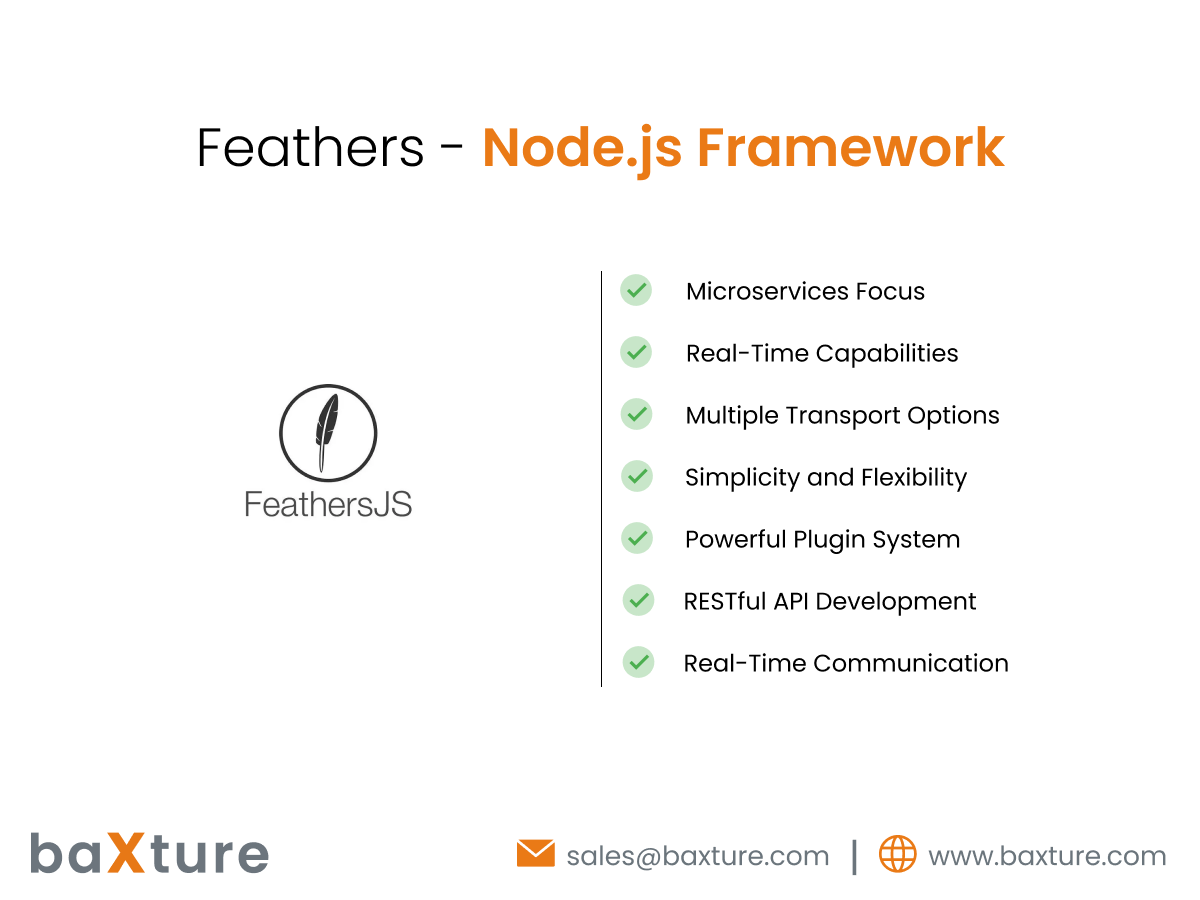
Feathers.js emerges as a dynamic microservices framework, with simplicity and flexibility at its core. This framework paves the way for developers to construct real-time applications and RESTful APIs with a blend of simplicity and power. A key strength of Feathers.js lies in its array of transport options—WebSocket, REST, and Socket.IO—enabling it to adapt effectively to diverse application scenarios. Complementing this versatility is a robust plugin system that empowers developers to seamlessly integrate third-party libraries and features, amplifying the capabilities of their applications.
Key Features:
- Microservices Focus: Feathers.js centers its design around microservices, offering a streamlined approach for constructing scalable and maintainable applications.
- Real-Time Capabilities: The framework is adept at crafting real-time applications, facilitating seamless data updates and interactive experiences.
- Multiple Transport Options: Feathers.js' support for multiple transport options—WebSocket, REST, and Socket.IO—caters to a wide range of communication needs.
- Simplicity and Flexibility: The framework's emphasis on simplicity and flexibility enables developers to achieve functionality without excessive complexity.
- Powerful Plugin System: A robust plugin system empowers developers to integrate external libraries and features, extending the application's capabilities.
- RESTful API Development: Feathers.js provides an efficient environment for developing RESTful APIs, aligning with contemporary application architectures.
- Real-Time Communication: Feathers.js' real-time capabilities make it a suitable choice for applications necessitating dynamic data exchange and interaction.
When to Use:
- Microservices Architecture: Feathers.js' focus on microservices makes it an apt choice for projects demanding scalability and modularity.
- Real-Time Applications: For applications requiring real-time data updates and interactive user experiences, Feathers.js' real-time capabilities are a valuable asset.
- Versatile Communication Needs: The framework's support for multiple transport options—WebSocket, REST, and Socket.IO—suits projects with diverse communication requirements.
- Simplicity-Centric Approach: Projects that prioritize simplicity and flexibility in their development process can benefit from Feathers.js' uncluttered design philosophy.
- Integration of Third-Party Libraries: Feathers.js' plugin system simplifies the integration of external libraries and features, making it suitable for projects that rely on specific functionalities.
- RESTful API Development: Feathers.js' streamlined architecture and support for RESTful API development align well with projects centered around data exchange.
- Dynamic and Interactive Applications: When applications demand dynamic data interactions and responsive interfaces, Feathers.js' real-time capabilities shine.
Feathers.js distinguishes itself with its microservices focus, real-time capabilities, and plugin system. By embracing simplicity, flexibility, and a versatile communication framework, it empowers developers to construct applications that deliver on both functionality and ease of use. Whether for microservices, real-time applications, or API-centric projects, Feathers.js' offerings make it a compelling choice.
Conclusion:
Node.js has transformed the way developers build applications, and the availability of various frameworks enhances its capabilities even further. The frameworks mentioned in this article – Express.js, Koa.js, Nest.js, Hapi.js, and Sails.js – cater to different application requirements and developer preferences. Before choosing a framework, consider the specific needs of your project, the scalability, and the community support. With the right Node.js framework, you can streamline your app development process and create high-performing, scalable, and efficient applications. Happy coding!